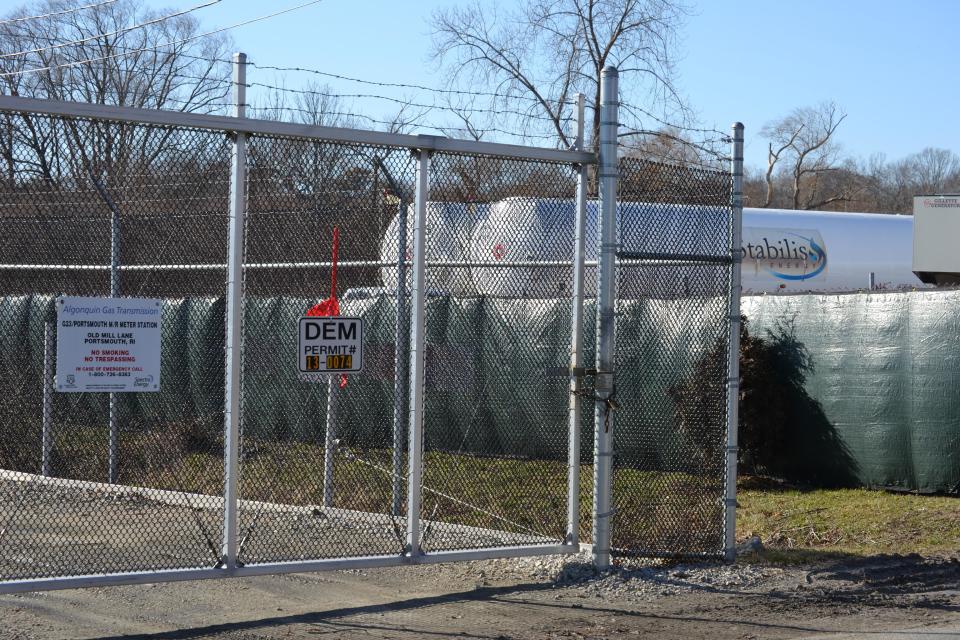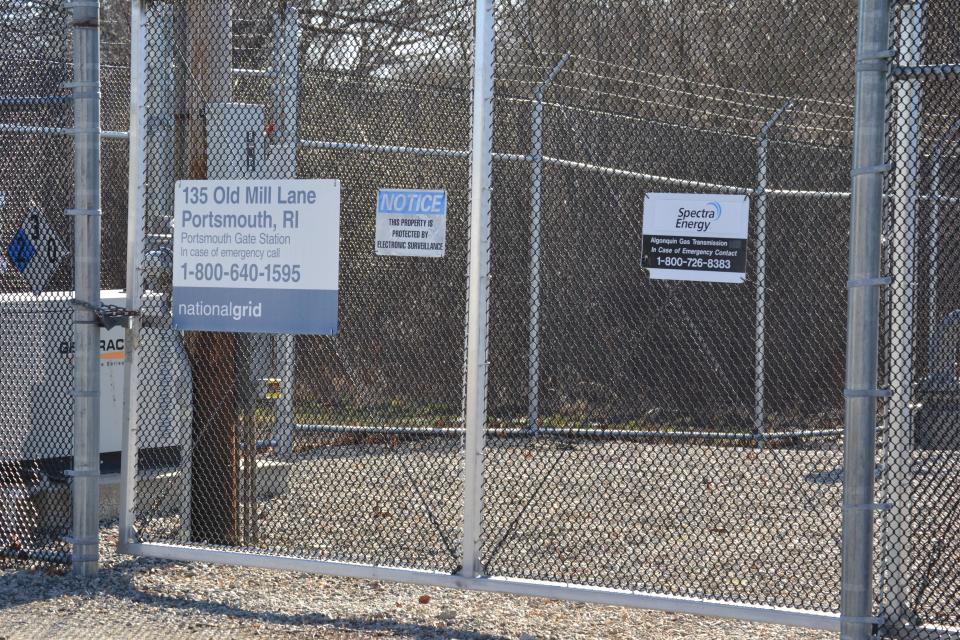Why a 'temporary' Portsmouth LNG site is expected to remain for another decade
PORTSMOUTH – Ever since a faulty valve in Weymouth, Massachusetts, caused Enbridge’s Algonquin natural gas pipeline to fail in January 2019 and threw Newport County residents into a heating crisis for a week, Portsmouth Town Councilor Keith Hamilton has been advocating for new natural gas infrastructure on Aquidneck Island.
Specifically, he wants a second pipeline connected to the island, both to serve as a redundancy for the existing line and to complete a loop system that would connect the island to the larger regional transmission network from two directions and address the potentially catastrophic issue of low pressure in the lines.
Hamilton has not approached Middletown or Newport with a specific proposal regarding a pipeline, nor did he submit anything to the Public Utility Commission’s first solicitation of public comment for its ongoing “Investigation Into the Future of the Regulated Gas Distribution Business in Rhode Island in Light of the Act on Climate,” but he has been vocal about the need for new natural gas infrastructure to serve Aquidneck Island at multiple Portsmouth Town Council meetings over the past several years.
“The pipeline dead ends in Bristol, and on Aquidneck Island,” said Hamilton. “If it crossed Aquidneck Island and continued to Jamestown and North Kingstown, coming in two directions, the other side can take up the pressure loss and avoid what happened in 2019.”

“If you loop the system together…the pressure is constant through the pipeline,” he added. “But the biggest issue is that you’re creating an industrial facility in a residential neighborhood, and we can’t have that. It was OK for short-term, but it’s not a long-term solution.”
The Act on Climate calls for ambitious greenhouse gas emission reduction targets en route to zero emissions in 2050
As Rhode Island begins the statewide process of working towards ambitious emissions reduction goals set forth in the 2021 Act on Climate (10% below 1990 levels by 2020; 45% below 1990 levels by 2030; 80% below 1990 levels by 2040; net-zero emissions by 2050) environmental and clean energy advocates such as the Acadia Center are calling for a complete moratorium on natural gas infrastructure, including a ban on residential and commercial hook-ups in new developments.
Hank Webster, senior policy advocate and Rhode Island director of the environmental policy non-profit Acadia Center, comes to a very different conclusion than Hamilton.
Gas or clean energy?:How should Aquidneck Island stay warm?
In a text message to the Daily News, Webster said, "We don't think the (Old Mill Lane LNG storage) facility is necessary if (Rhode Island Energy) instead pursued investing in improvements that actually benefitted their customers, like weatherization, cleaner, safer appliances, and demand response programs. Proposals to build new infrastructure only benefit the companies building the project and the companies selling the gas.”
He continued, “Let's not forget that the federal and state government found that the January 2019 outage only occurred because of an extraordinary coincidence of management failures and lack of attention to existing infrastructure like an upstream valve and backup power module. Without any one of those, the outage would not have occurred, and we would not be seeing these proposals for new long-lived infrastructure."
Rhode Island residents and businesses depend heavily on natural gas as an affordable heating source
According to the US Energy Information Administration, natural gas fueled 87% of Rhode Island's electricity net generation in 2021, the largest share of any state.
Additionally, it is clear given the reality of Rhode Island Energy’s continued seasonal dependence on an extra LNG storage facility in Portsmouth that the existing natural gas infrastructure supplying Aquidneck Island does not operate at a high enough capacity to ensure Newport stays fully supplied at peak demand. Even advocates of renewable energy solutions – including every panelist on a recent discussion hosted by the state Public Utilities Commission entitled “Abandon or Replace: the future of the regulated gas distribution business in Rhode Island in light of the Act on Climate” – openly acknowledge that the electrical grid as it currently exists cannot meet Rhode Island’s demand without natural gas continuing to serve as an important and affordable supplemental energy source for decades to come.
“The Act on Climate…is an act that puts in place arbitrary deadlines that can’t be reached in order to create a utopia greenhouse environment,” Hamilton told The Daily News. “We can’t be putting arbitrary deadlines when we don’t have the capacity to meet those.”
In its 127-page Aquidneck Island Long-Term Gas Capacity Study prepared in September 2020, Rhode Island Energy stated outright the maximum capacity of natural gas capacity from at the Portsmouth take station on Aquidneck Island cannot currently meet Aquidneck Island’s projected peak demand. The study further explained the projected natural gas demand growth for Aquidneck Island will only exacerbate this gap between the projected peak gas demand on the island and the pipeline’s current maximum capacity.
From 2020:State board rules against National Grid on Old Mill Lane LNG facility
However, the study also clarified the gap between pipeline capacity and demand is not a result of a spike in local demand in Newport County: “Rather, changes in AGT operating practices effectively limited the pipeline capacity that the Company can count on during periods of extreme cold. In essence, a gas capacity/demand gap materialized “overnight” with a change in AGT practice that limited how much capacity the Company can plan to use to meet customer needs when demand is highest. This necessitated the portable LNG operations at the Old Mill Lane facility in Portsmouth, which presently fill the capacity/demand gap.”
“We have to weigh cost with safety. Having those tanks in a residential neighborhood, outside the nuisance of noise, it is unsafe to have those tanks there in that neighborhood as opposed to having that pipeline," Hamilton said. "Rhode Island Energy knows it, the state Energy Facility Siting Board (EFSB) knows it, and everyone supporting green energy knows it.”
Building a second pipeline for Aquidneck Island is a tough political sell as Act on Climate comes into effect
Despite the state’s continued reliance on natural gas and local concern in both Middletown and Portsmouth about the siting of an industrial LNG storage facility in a residential neighborhood, there seems to be limited appetite at the state level for an infrastructure project of the magnitude Hamilton has in mind. This is not least because pushing for a second pipeline to the island would necessitate a huge political battle at a time when Acadia Center and other Act on Climate advocates in the state legislature and in the ranks of Rhode Island’s registered lobbyists are beginning to actively fight for a moratorium on natural gas infrastructure and eventually full abandonment of natural gas as an energy source.
On the other hand, finding a pathway for Rhode Island energy consumers who have expressed a preference on the free market for natural gas heating systems to switch to alternatives and meet Act on Climate emissions goals by 2050 may be just as heavy of a political lift as trying to convince environmental and renewable energy advocates that Aquidneck Island needs a second pipeline. In addition to being widely used in Rhode Island’s residential areas, natural gas fuels powerplants in Tiverton and elsewhere and is the preferred heating source for large industrial clients including Electric Boat, Toray Plastics and other prominent tenants of the Quonset business park in North Kingstown.
Previous coverage:Could homeowners around National Grid's Portsmouth LNG site be getting an offer?
Middletown communications officer Matt Sheley took a diplomatic line on the series of proposed alternatives to the Old Mill Lane storage facility offered by Rhode Island Energy in 2020, but acknowledged Middletown residents who live close to the facility share similar safety concerns with their neighbors in Portsmouth.
“We don’t have a formal position on a specific alternative – I think if you asked (Town Council President) Paul Rodrigues he would prefer (a second) LNG pipeline, but we as the town haven’t made a definitive choice,” said Sheley. “The town hasn’t honed in on a specific alternative that we prefer, but it does seem like Rhode Island Energy has focused on the least costly alternative rather than what’s best for the town of Middletown and its residents.”
What's happened since the 2019 Aquidneck Island gas outage?
Rhode Island Energy’s solution since then has been to set up a seasonal facility that uses trucked-in liquefied natural gas (LNG) to restore pressure to the system during periods of high demand. The facility is operational from December 1 to March 31 and is mainly used on the coldest days of the year in order to avoid another shut-off like the disaster many residents of Newport experienced in 2019.
The solution, which was billed to Middletown and Portsmouth residents in the area as temporary when it was implemented in the wake of the 2019 fiasco, entails the LNG being delivered by truck, then vaporized, and then entering the system through a tap on-site. The facility is at the take station at 135 Old Mill Lane in Portsmouth, which meets up with a lateral Algonquin line that runs across the bed of the Sakonnet River from Fall River and Tiverton and distributes the gas to end users on Aquidneck Island.

Despite mounting public backlash from neighbors who have seen the facility in their backyards expand its capacity from one to five portable LNG tanks over the course of the past four winters, public documents submitted by Rhode Island Energy to the PUC and the state’s Energy Facility Siting Board indicate this “temporary situation” is likely to be in place for at least another decade to come, at an estimated cost of $31 million as opposed to $147 million for the construction of a second pipeline extending from the main line in southern Massachusetts. Webster and Acadia Center’s preferred solution, weatherization and electrification, is the most expensive option at $190 million.
According to the Rhode Island Office of Energy Resources, the vast majority of natural gas consumed in Rhode Island arrives via pipelines developed and operated by the Algonquin Gas Transmission Company and the Tennessee Gas Pipeline Company. The remainder is transported as LNG to the state via tanker trucks. The Algonquin Gas Transmission is an interstate pipeline that transports natural gas from New Jersey throughout New England. The Tennessee Gas Pipeline is a major interstate pipeline that extends from the Texas / Mexico border to eastern Massachusetts.
According to Rhode Island Energy, the storage facility at Old Mill Lane “provides sufficient capacity presently to largely avoid customer service interruptions even in the face of the loss of nearly 50% of the expected gas capacity from AGT at Portsmouth during extremely cold conditions. Even with loss of 100% of AGT capacity due to a disruption, Old Mill Lane LNG could support the majority of customers on Aquidneck Island.”
This article originally appeared on Newport Daily News: Portsmouth LNG site on Old Mill Lane to remain for next decade

